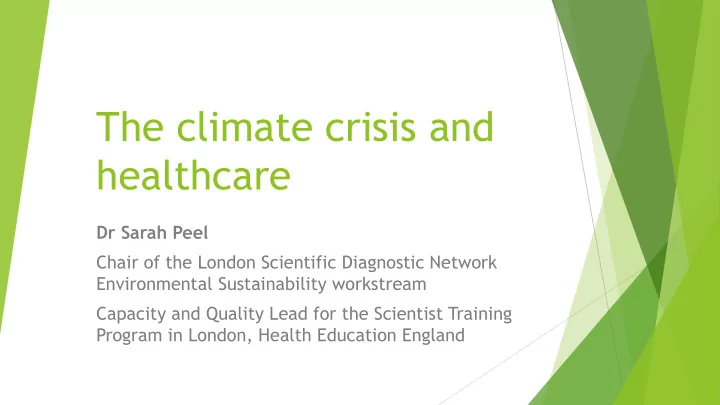

The climate crisis and healthcare Dr Sarah Peel Chair of the London Scientific Diagnostic Network Environmental Sustainability workstream Capacity and Quality Lead for the Scientist Training Program in London, Health Education England
The climate crisis and health Climate change and its impacts on health The environmental impacts of healthcare The unique contribution of clinicians and the NHS
CO 2 concentrations and temperature https://www.ncdc.noaa.gov/global-warming/temperature-change
https://climateactiontracker.org/global/temperatures/
https://www.newscientist.com/article/mg20126971-700-how-to-survive-the-coming-century/
The Lancet report on climate change November 2019 https://www.thelancet.com/journals/lancet/article/PIIS0140- 6736(19)32596-6/fulltext
Climate change impacts, exposures, and vulnerability health and heat health and extreme weather events global health trends in climate-sensitive diseases climate-sensitive infectious diseases food security and undernutrition https://www.thelancet.com/journals/lancet/article/PIIS0140- 6736(19)32596-6/fulltext
Number of heatwave exposure events in people aged >65 years https://www.thelancet.com/journals/lancet/article/PIIS0140-6736(19)32596-6/fulltext
Heat waves https://www.theguardian.com/environment/2006/jul/26/science.g2
Heat-related mortality curve Mapping estimated heat-related mortality in London due to population age, urban heat island, and dwelling characteristics Jonathon Taylor et al UCL London, City Hall, 28th October 2015Heat Risk in London group meeting
2018 heat-wave Nearly 700 more deaths than average were recorded during the 15-day peak of the heatwave in June and July in England and Wales “The people most at risk in a heatwave are the frail elderly with heart or kidney problems.” Dr Adrian Boyle of the Royal College of Emergency Medicine https://www.theguardian.com/society/2018/aug/03/deaths-rose-650-above-average-during- uk-heatwave-with-older-people-most-at-risk
What individual and neighbourhood level factors increase the risk of heat related mortality? Temperatures were higher in neighbourhoods with lower levels of urban vegetation Temperatures higher with higher levels of income deprivation, social-rented housing, and non-native English speakers https://researchonline.lshtm.ac.uk/id/eprint/4655678/1/Murage_etal_2019-What- individual-and-neighbourhood-level-factors-increase-the-risk-of-heat-related-mortality.pdf
Failure of climate change World mitigation and adaption Economic Extreme weather events Water crises Forum Weapons of Natural disasters mass destruction Impact Likelihood
Carbon footprint of healthcare Globally, healthcare’s carbon footprint accounts for 4.4% of the world’s net C02 emissions. If healthcare were a country it would be the fifth largest emitter on the planet. Health Care Without Harm (HCWH) report https://noharm-global.org/articles/news/global/webinar-health- care’s -climate-footprint-report-findings-and-opportunities
Carbon footprint of healthcare The NHS produces higher emissions than the global average for healthcare and is responsible for 5.4% of the UK’s total carbon emissions Equivalent to 11 coal-fired power stations not much lower than those for both aviation, and agriculture, forestry and land use in the UK (each 6.5%) Health Care Without Harm (HCWH) report https://noharm-global.org/articles/news/global/webinar-health- care’s -climate-footprint-report- findings-and-opportunities
Medical Id Identify fyin ing car arbon hot otspots instruments Pharmaceuticals Inhalers Anaesthetic Energy gases SDU 2018. Reducing the use of natural resources in health and social care 2018 report
Decarbonising healthcare Eg. • Grid decarbonisation • Vehicle efficiency • Supports 30% reduction Eg. • Energy and travel efficiency • Anaesthetic gases, Inhalers • Models of care • Public health • Supports 58% reduction https://www.sduhealth.org.uk
What impact can clinicans have?
Reducing the environmental impact of healthcare Tri riple Bottom Lin Line outcomes for patients and populations Sustainable value = environmental + social + financial costs (the “triple bottom line”) Academy of Medical Royal Colleges, 2016 (with the Centre for Sustainable Healthcare)
Inhalers The most commonly used inhaler in the UK has a carbon footprint of 28kg per inhaler. Dry powder inhalers have a carbon footprint of less than 1kg Dr Alex Wilkinson https://greeninhaler.org/
Environmental impact of switching inhalers Dr Alex Wilkinson https://greeninhaler.org/
NICE encourages use of greener asthma inhalers The aid describes the different types of inhaler which may be used by the estimated 5.4m people in the UK who have asthma 26 million prescriptions for metered dose inhalers were written in primary care in England in 2016/17. They made up 70% of UK inhaler sales in 2011, compared with just 10% in Sweden. https://www.nice.org.uk/news/article/nice-encourages-use-of-greener- asthma-inhalers
Important to involve patients and the public in the discussion about how to reduce our carbon emissions
Introduction of LINQ heart rhythm monitors by Dartford & Gravesham NHS Trust Currently, implantable loop recorders are offered - requiring the specialist skills of a consultant to implant. LINQ heart rhythm monitors can be fitted away from the pacing lab by a physiologist rather than a consultant https://map.sustainablehealthcare.org.uk/projects
Introduction of LINQ heart rhythm monitors by Dartford & Gravesham NHS Trust No follow up appointments A radical reduction in the length of day patient visits, shrinking energy demands per intervention and increasing throughput Less equipment and clinical waste Reductions in sedation Reduction in nursing and consultant staff time Free up consultant time to perform more complex cases Savings per year: £50,985 (Estimated) CO2 savings per year: 23.3 tonnes CO2e (Estimated)
Clinicians making an impact at work Dr C Swarbrick, Dr P Valentine, Royal Devon and Exeter NHSFT 2019
The sustainability agenda
Recommend
More recommend